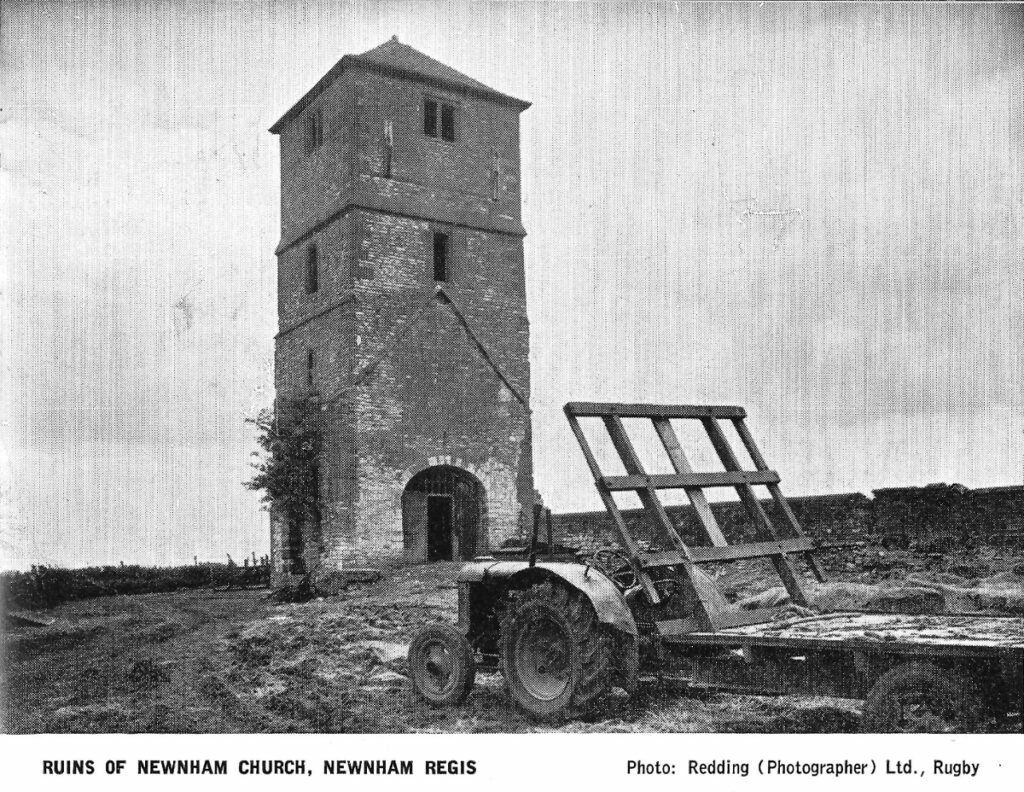The Rugby Rural District Council published a guide to the 40 villages it administered. These profiles include a brief history of each village. The version of the profile from 1968 can be found below – with the understanding of village history of those times.
NEWNHAM REGIS, Near Rugby (Area: 1,471 acres. Population : mid-1967, 100) This little village is known as Kings Newnham from having formerly belonged to the King, though from Henry I to Henry VIII it belonged to the Canons of Kenilworth. Many remains of Ancient Britons and of prehistoric monsters have been found here, mostly in the now disused limestone pits, which have yielded bones of the elephant, mammoth, ox, rhinoceros and the first hyena ever found in England (1882). In the farmyard of 18th century Newnham Hall is an old ivy-clad church tower-all that remains of the 13th century Church of St. Laurance probably built by the Monks of Kenilworth. A former rector wishing residents to worship at Church Lawford, stopped all services here (except once a year for the “wake”) and in 1794 the nave and chancel were destroyed, before the Bishop intervened to save the tower. The walls of the chapel had frescoes by Jacob Jordaens, a pupil of Rubens, some of which were hacked off with a pick and given to Rugby School Museum. The Manor House and the Barn at The Hall are both of interest. Dugdale attributes the depopulation of this village to the inclosures made by the Lord of the Manor and it is an example of a deserted village compared with its previous importance when it belonged to the Canons of Kenilworth, who had a Court Leet and other privileges here in the times up to Henry VIII.
Near where the River Avon turns southwards were Newnham Regis Baths, famous in Queen Elizabeth I’s time as a cure for gout, rheumatism and dyspepsia, and much visited for the waters (a weak lime or chalybeate) as at Leamington Spa today. In 1582, Queen Elizabeth’s physician (Dr Walter Bailey, M.D.) published a paper on their great value. The Baths were much frequented at the beginning of the 17th century. In 1857 they were restored, but little now remains but stone walls.

CHURCH LAWFORD, Near Rugby (Area: 1,829 acres. Population: mid-1967, 500) This ancient village known as Leileford in Domesday Book, lies just off the main Rugby-Coventry road (A428). Its church -а handsome stone structure in the Late Decorated Style, dedicated to St. Peter, was rebuilt in 1873-74, embodying three bays of the 14th century north arcade and the 14th century font. During the rebuilding a 14th century piscina was discovered high up in the nave to serve a rood-loft altar. The embattled tower contains six bells, the last two added in 1937.
The village has had its own Church from earliest times, the living originally being in the patronage of the Abbot and Convent of St. Peter’s-super-Dinam in France. The registers (incorporating Kings Newnham) go back to 1575 and include many names of the ancestry of President J. A. Garfield (1831-81) the 20th President of the United States of America. Garfield was the second President to be assassinated in office, the first being Abraham Lincoln sixteen years before. (See in this connection, W. M. Thayer’s book “From Log Cabin to White House”). James Garfield (of Ohio) was a skilled orator, having been admitted to the Bar in 1859. He was elected to Congress in 1862, to the Senate in 1881 and was inaugurated as U.S. President on March 4th 1881 only to be shot at Washington railway station by Charles Guiteau (a disappointed office-seeker) on 2nd July 1881. The old Elizabethan Manor House has a wooden frame (older than the walls) with the beams visible both inside and outside. The Rectory, and the White Lion Inn are also of interest. There is a village hall; and a stone obelisk serves as a memorial to those who fell in the two World Wars. Past excavations have revealed remains of elephants, rhinoceros and hyena buried in the diluvial deposit. Gas, electricity and water are available; there is a good bus service. A former Royal Air Force Aerodrome here, took its name from this village, but this was sold in 1966, except for married quarters which remain in use (in Long Lawford parish).
